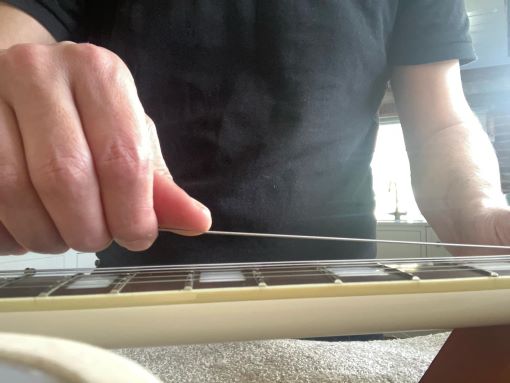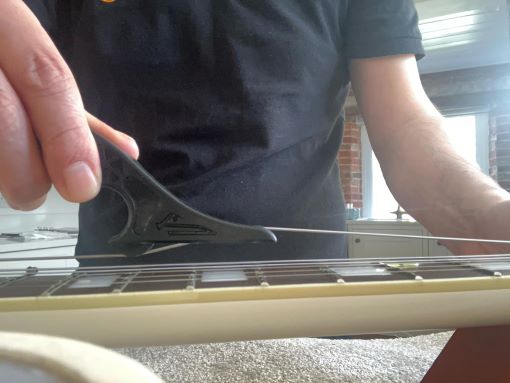STRETCHING STRINGS
New strings need to be stretched before they’ll stay in tune. If you don’t stretch them, for the first 2-3 hours of play they’ll repeatedly go flat in pitch.
There are conflicting views on how to stretch strings, and even whether they need stretching at all. Here’s our take on the subject.
We’ll look at three different ways of stretching strings, applicable to all types of guitars including bass guitars. Bear in mind that while we will talk about stretching strings, some of what you’re doing is also removing slack from the strings (this is something different).
Why do strings need stretching?
Strings have elasticity. They need this in order to oscillate and sound musical. When you strike a string and it oscillates, or when you bend it, its length changes (it gets longer). In other words, it stretches. New strings go through an initial period of stretch until the string has reached a stable length. Stretching your strings when you install them allows you to fast-forward through this ‘settling in’ period so when you start playing the string has already reached a stable length and, as a result, more stable tuning. Stretching your strings also helps to make sure that the string is pulled tightly around the string post without any slack (not an issue if you use locking tuners), that the ball-end of the string is properly seated (often an issue on acoustic guitars that use bridge pins) and that tension is evenly distributed along the string reducing the risk of breakage.

1. Stretching by hand – pulling (one-handed technique)
One common method of stretching strings involves gently pulling up on the string, at a single point (usually around the 12th fret) or repeatedly along the length of the string. Do this for each string, re-tune the strings and repeat if necessary. Hold the guitar in the playing position while you do this – it just makes things easier – and tune up to pitch first.
Some sources give variations on this method, such as holding the string down with one hand while pulling the string with the other, or pulling the string up at specific points (e.g. 3rd fret, 7th fret, 12th fret).
Wherever you pull on the string, don’t pull too hard or too high off the fretboard. If you pull too hard the strings can break, especially the lighter strings (high E, B and G strings), so go easy. You can always repeat the process if the string needs more stretching. And don’t ‘snap’ the string down on the fretboard once you’ve pulled it up – let it down gently.

2. Stretching by hand – pushing (two-handed technique)
This method is similar to the above but involves lifting the string at two points, using each hand, and then pressing down on the string in the area between those two points with your thumbs. Do this up and down each string. This method is easier to apply with the guitar lying flat on its back, and you may need a little slack in the strings.
Our experience is that the risk of accidentally breaking a string is much lower with this method. This is because the stretching comes not from the lifting of the string (which can snap if you lift too much) but rather from the pressing you do with your thumbs.
It is a little harder on the hands though and, because it focuses only on the portion of the string between the nut and saddles, it may not fully pull out any slack that exists at the string posts or where the string is seated in the bridge.

3. Using a string stretcher
A quick, easy and effective method of stretching strings is to use a tool imaginatively called a ‘string stretcher’. This handy tool reproduces the ‘pressing’ action described above but, rather than having to repeat that action up and down the string, you can simply slide the tool back and forth. Running the tool up and down each string 5-6 times is usually sufficient and takes a matter of seconds.
Slacken the strings slightly first because the tool needs a bit of clearance above the fretboard. Don’t use the string stretcher on strings tuned to pitch – that’s a good way to break a string!
You’ll be amazed at how well this tool works, and it takes (almost) all the thought out of string stretching allowing you to get on with what you really want: playing!
Guitars with locking nuts
If your guitar has a locking nut, stretch your strings before tightening the nuts.
Guitars with floating bridges
Stretching strings is always necessary, but it is absolutely essential if you are setting up or changing strings on a ‘floating’ bridge like a Floyd Rose. Loss of tension in one string (due to stretching, or the pulling out of slack) will throw off the balance of the entire bridge so it’s important that all the strings are fully stretched first. You have been warned! 😉
If you have tips on stretching strings, we’d love to hear them.
Join us on Facebook
NEED HELP CHANGING STRINGS?
See our list of services to learn more about how we can help, or get in touch using the button below.
